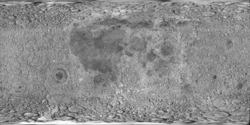Feuillée (kráter)
| Kráter Feuillée | |
|---|---|
 Kráter Feuillée | |
| Souřadnice na Měsíci | |
| Selenografická šířka | 27,4° S |
| Selenografická délka | 9,5° Z |
| Další údaje | |
| Průměr kráteru | 9,5 km [1] |
| Hloubka | 1,8 km [1] |
| Colongitudo | 10° |
| Eponym | Louis Feuillée |

Feuillée je měsíční impaktní kráter nacházející se ve východní části Mare Imbrium (Moře dešťů) východně od výrazného kráteru Timocharis na přivrácené straně Měsíce. Má průměr 9,5 km a je hluboký 1,8 km[1], pojmenován je podle francouzského přírodovědce a astronoma Louise Feuilléeho.[1][2]
V jeho těsné blízkosti se nachází zhruba stejně velký kráter Beer, východo-severovýchodním směrem leží kráter Bancroft. Jiho-jihozápadně leží malý kráter Pupin, jiho-jihovýchodně kráter MacMillan.
Odkazy
Reference
Literatura
- RÜKL, Antonín. Atlas Měsíce. Praha: Aventinum, 1991. ISBN 80-85277-10-7.
Externí odkazy
 Obrázky, zvuky či videa k tématu Feuillée na Wikimedia Commons
Obrázky, zvuky či videa k tématu Feuillée na Wikimedia Commons - Crater Feuillée on Moon Gazetteer of Planetary Nomenclature, IAU, USGS, NASA (anglicky)
- LAC 41, mapa 1:1 000 000 (Lambertova projekce)
Média použitá na této stránce
cylindrical map projection of the Moon. The Moon's whole surface was mapped by the Clementine spacecraft in 1994, here North is at the top. The dark floor of crater Plato is at the middle top above Mare Imbrium, while the bright floor and rays of crater Tycho is near the middle bottom below Mare Imbrium. Mare Procellarum is at the near left, and Mare Tranquillitatis is just right of centre and Mare Crisium is at the near right. The far left and far right show the contrast of the mostly cratered farside with small isolated mare.
Feuillee lunar crater as seen from Earth with satellite craters labeled
Autor: M. Gålfalk, G. Olofsson, and H.-G. Florén; SIRCA camera, Licence: CC BY-SA 3.0
The Archimedes crater of the Moon and other features.
Archimedes is the largest crater near the center of the picture. It lies within the Mare Imbrium. The other large craters are Aristillus (to the right of Archimedes and higher, with pronounced central peak) and Autolycus (to the right and lower). At the lower right edge of the picture parts of the Montes Apenninus are visible.
Infrared image in L band centred on 3.75 micrometres. Taken with the SIRCA camera by M. Gålfalk, G. Olofsson, and H.-G. Florén. Nordic Optical Telescope, Stockholm Observatory. More images can be found here


